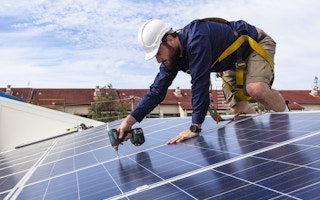Despite recent political developments spelling an uncertain future for climate change research, green energy is still increasing at an exponential rate. In 2015 alone, 147 gigawatts of renewable electricity came online.
To continue reading, subscribe to Eco‑Business.
There's something for everyone. We offer a range of subscription plans.
- Access our stories and receive our Insights Weekly newsletter with the free EB Member plan.
- Unlock unlimited access to our content and archive with EB Circle.
- Publish your content with EB Premium.
This is the largest annual increase in the history of the sector. More than twice as much money was spent on renewables than on coal and gas-fired generation, with $130 billion spent in 2015. In total, renewables contributed to 10.3 per cent of the electricity generated globally.
The EU is a leader in the production of renewables, which account for 44 per cent of the entire EU’s electricity capacity and 15 per cent of its final energy consumption. Between 2004 and 2011, 70 per cent of all new power capacity in the continent came from renewables.
Recent political changes have witnessed a shift in renewable energy perception. What does Brexit and the new UK government mean for the EU’s renewable sector? The UK was fourth in the world’s top investing countries in renewable energy (excluding hydroelectricity) – with a 25 per cent growth in its investment since 2014.
However, it has scrapped its Department of Energy and Climate Change (DECC) following a decision by Theresa May and has invested in nuclear power at Hinkley Point. The only other EU country to feature in the top 10 is Germany, which has experienced a -46 per cent fall in investment since 2014.
Finances aside, the EU is still by far one of the world’s largest producers of renewable energy. The UK’s turbulent energy announcements following the decision to leave the EU leave one question remaining: what will our departure from the EU mean for renewable energy?
“
The departure of the UK will no doubt impact the renewable progress of the EU – but perhaps it will be a positive thing for the organisation as a whole.
Current targets
The EU is currently a global leader in renewables, increasing its production of renewable energy by 73.1 per cent between 2004 and 2014, which is equivalent to a 5.6 per cent increase per year. All 29 member states are targeted to achieve a certain percentage of energy production through renewable methods by 2020 (although this varies depending on the country). However, many countries are falling behind.
The UK is currently the furthest behind on its target, 10 per cent short of its 15 per cent goal for 2020. However, investment has risen and the UK renewable share has quadrupled, which is a feat matched only by Belgium, Luxembourg and Malta.
Based on the growth that occurred between 2010 and 2013, 11 of the 29 EU member countries will miss their 2020 targets. Conversely, the Nordic member states are showing incredible improvements. Sweden had already exceeded its target of 49 per cent of energy consumption through renewables by 2013, hitting 52.1 per cent.
Bulgaria and Estonia have also beat their target, with Bulgaria hitting 19 per cent against its 2020 goal and Estonia 25.6 per cent against its 25 per cent target. Six other countries have followed suit, with the Czech Republic, Croatia, Italy, Lithuania, Romania and Finland all meeting their 2020 targets.
Considering the UK is the furthest behind on its targets, its departure from the European Union could actually improve the EU’s renewable outlook.
The countries that produce the most renewable energy (and how they produce it)
Germany was the largest gross producer of renewable energy within the EU28 in 2014. Driven by Angela Merkel’s “Energiewende” policy, the country aims to phase out nuclear and fossil fuels. The country is the leading producer of solar energy, generating 38,250 megawatts of solar energy yearly.
Scotland may provide a blow to the EU’s renewable target if the country leaves. Scotland is a world leader in wind power, with 97 per cent of all household electricity needs supplied by wind turbine energy.
Sweden, as already mentioned, is the first country to exceed its 2020 target – but there are no signs of slowing down as the country targets becoming 100 per cent renewably powered. It is currently on target to hit this figure by 2040. In 2015, 57 per cent of its overall energy was produced by renewables, largely from wind.
Denmark is another EU leader, producing 140 per cent of its electricity through wind power alone in 2015 thanks to high winds. Despite this, the country is still 1 per cent behind its 2020 target. However, the country is seeing an 18 per cent year-on-year growth in wind energy production and expects to meet its target.
Iceland is not an EU country, but is a member of the European Free Trade Association. It serves as an example to all European continent countries, as it is operates on 100 per cent renewable energy, with hydroelectric and geothermal sources accounting for its main methods of production.
Looking at the facts and figures, the UK’s current position on renewable energy is not promising. Not only is the country trailing EU targets, its global position is slipping. However, Scotland remains a strong example of effective renewable energy. The departure of the UK will no doubt impact the renewable progress of the EU – but perhaps it will be a positive thing for the organisation as a whole.
Colin Sadler is the Head of Lycetts Commercial Division based at Lycetts head office in Newcastle. This article was written exclusively for Eco-Business.


















